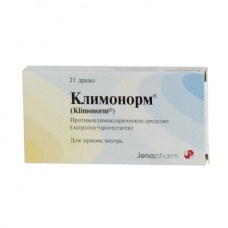Expiration date: 05/2026
Structure and Composition:
Dragee. 1 dragee of yellow color contains:
2 mg estradiol valerate
1 dragee of brown color contains:
2 mg estradiol valerate
0.15 mg levonorgestrel
Excipients: lactose monohydrate, potato starch, polyvidone 25,000 talc magnesium stearate, sucrose, glucose syrup, gelatin, macrogol 35,000 calcium carbonate titanium dioxide E171 Iron oxide yellow iron oxide, red iron oxide brown carnauba wax
in a blister pack with a calendar scale of 21 pcs. (9 of 12 yellow and brown pills) in a cardboard box 1 blister.
Description pharmaceutical form:
Round yellow pills (9 pills) and brown (12 pills).
Pharmacokinetics:
Estradiol valerate and levonorgestrel is rapidly and well absorbed from the gastrointestinal tract. Estradiol valerate is rapidly metabolized with the formation of a highly active 17-beta-estradiol and estrone, which are subject to further metabolic transformations. Estradiol valerate is excreted as metabolites in the urine (90%) and bile, levonorgestrel as conjugates - in the urine and bile.
Description of the pharmacological actions:
Klimonorm contains estrogen - estradiol valerate, in which the human body is converted into 17 natural estradiol & beta-. Also in the preparation klimonorm includes a derivative of progesterone - levonorgestrel. The addition of levonorgestrel within 12 days of each cycle prevents the development of endometrial hyperplasia and cancer.
Due to the composition and cyclic regimen klimonorm (receiving estrogen alone for 9 days, and then - a combination of estrogen and progestogen for 12 days, and finally to 7-day rest period) in women with unremoved uterus at regular intake of the drug is established menstrual cycle.
Estradiol restores deficit of estrogen in the female body after menopause and provide effective treatment for psycho-emotional and vegetative menopausal symptoms (such as "hot flashes", sweating, insomnia, increased nervous excitability, irritability, palpitations, false angina, dizziness, headache, decreased libido, muscle and joint pain) involution of the skin and mucous membranes, especially the mucous membranes of the genitourinary system (urinary incontinence, dryness and irritation of the vagina, pain during sexual intercourse) reduces the risk of cardiovascular disease. Inhibits proliferative processes in the endometrium and reduces the risk of developing endometrial cancer.
Estradiol prevents bone loss caused by estrogen deficiency. This is mainly due to the suppression of bone remodeling toward bone formation of osteoclast function and process shift. It has been proven that long-term use of hormone replacement therapy (HRT) can reduce the risk of fractures of the peripheral bone in women after menopause. If you cancel HRT rate of decline in bone mass comparable to the characteristic of the period immediately after menopause. Do not proven that using HRT, it is possible to achieve the restoration of bone mass to premenopausal levels.
HRT also has a beneficial effect on the collagen content of the skin, as well as its density, and can also slow down the formation of wrinkles.
Receiving klimonorm leads to lower total cholesterol, low density lipoproteins (LDL) and increasing high density lipoprotein (HDL), resulting in a significantly increased ratio of HDL / LDL, and an increase in triglycerides.
Observational studies suggest that among postmenopausal women using HRT reduced incidence of colon cancer. The mechanism of action is unclear to date.
Testimony:
- hormone replacement therapy in pre- and postmenopausal women, including after surgical removal of the ovaries
- climacteric syndrome (mental and vegetative symptoms) in peri- and postmenopausal women
- atrophy of skin and mucosal membranes (including the urogenital organs) in postmenopausal
- signs of irritation of the bladder and urethra, urinary incontinence in a stressful situation (when the bladder sphincter atrophy) in postmenopausal women
- prevention of postmenopausal osteoporosis.
Contraindications:
- hypersensitivity to the drug
- severe dysfunction and liver tumors (including history)
- congenital disorders of lipid metabolism
- embolic processes (including history)
- myocardial infarction
- acute cerebrovascular accident
- hormone dependent tumors of the uterus, ovary and breast have or suspected
- endometriosis and abnormal genital bleeding
- diabetes (severe), diabetic angiopathy
- idiopathic jaundice, pruritus, herpes, progressive otosclerosis during a previous pregnancy
- pregnancy
- lactation.
Application of pregnancy and breastfeeding:
Contraindicated during pregnancy. At the time of treatment should stop breastfeeding.
Side effect:
Rarely can be:
From the digestive tract: during the first treatment cycle may be gastrointestinal disorders, nausea, vomiting.
With the genitourinary system: irregular, enhanced and prolonged vaginal bleeding.
For the skin: pigmentation on the skin (chloasma), pruritus.
Other: breast tenderness, weakening of libido.
Drug Interactions:
Reduce drug activity, accelerating the biotransformation of steroid hormones: barbiturates, narcotic analgesics (phenylbutazone), antibiotics (rifampicin, ampicillin, tetracycline, griseofulvin), antiepileptics (carbamazepine, phenytoin).
Dosage and administration:
Inside, pills swallowed whole with a little liquid. The time of day when a woman takes a drug, it does not matter, however, if she began taking pills at any given time, it must adhere to this time and beyond. If a woman forgets to take pills, it can take it over the next 12-24 hours. If treatment is interrupted for a longer time, you may experience vaginal bleeding.
If the patient is still ongoing menstruation, treatment should begin on day 5 of the menstrual cycle (1st day of menstruation corresponds to the 1st day of the menstrual cycle).
Patients with amenorrhea or very infrequent menses and postmenopausal women, can start taking the drug at any time, provided that the pregnancy is excluded.
Each package is designed for a 21-day reception.
Every day for the first 9 days of taking one yellow pellets, and then for 12 days - one daily brown pellet. After 21 days of receiving the drug should be a 7-day break in reception, during which bleeding occurs menstrualnopodobnoe caused by the abolition of the drug (usually 2-3 days after receiving the last pills).
After a 7-day break in taking the drug klimonorm start a new pack, taking the first pills on the same day of the week as the first pellets from the previous package.
Precautionary measures:
Do not use as a contraceptive agent. Prior to application it is necessary to conduct gynecological control and Pap smear, breast examination and liver function, blood pressure control, cholesterol levels in the blood and urine analysis. Caution should be used in patients with diabetes accompanied by vascular changes in hypertension, varicose veins, phlebitis, otosclerosis, multiple sclerosis, porphyria, sickle-cell anemia. Efficiency is reduced by excessive alcohol consumption. It should stop taking the drug with frequent migraine headaches, severe visual impairment, hearing loss and other symptoms of sensory dysfunction, acute thrombosis, thromboembolic disorders, stagnation of bile, jaundice, constant itching, upon detection of tumors of the liver, a significant increase in blood pressure, frequent epileptic seizures, prolonged bedrest for 6 weeks prior to surgery. Patients with diabetes mellitus may change the dosing regimen hypoglycemic agents.


